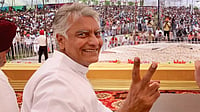As Kerala continue to log 30,000 cases over the past few days, public health expert, Scientific Advisor and former President of The Indian Medical Association, Dr. Rajeev Jayadevan spoke to Outlook about the reasons behind the post-Onam surge and state’s response to Covid-19.
Q) Kerala has been logging 30,000 Covid-19 cases over the past couple of days after Onam. While cases are falling in other states, is the situation in Kerala a cause for alarm?
The surge after the Onam festival was anticipated for two reasons. During last year Onam too, the state had a similar surge in September - October. That was the only surge we saw in Kerala. The same situation will repeat this year for many reasons. People's behavioral pattern recurs every year. Weather changes are very much constant in Kerala. My argument is that Onam-related social activities may not be the sole reason for the current surge. It’s a result of other factors like the environment too. Any infectious disease follows what is called an epidemiological triangle. This triangle consists of three elements. The agent, host, and the environment and three require proper attention.
Broadly speaking, there may be ideal environmental conditions that facilitate droplet spread of the virus, particularly in indoor settings. These environmental factors include temperature, humidity, air exchange rate, room ventilation, and evaporation rate.
My hypothesis is that August- October is the best environmental condition for the virus to spread in Kerala. Kerala and Colombo have the same weather conditions. Colombo also faces similar problems. That is the closest proof to support my argument that environment is also a main factor. Even before Onam, cases were hovering around 20,000 or so. Whenever there is a surge, it turns into a political blame game.
The spread of the virus in a region is always stochastic and no region in the world has a uniform spread. The countries which performed well last year in curbing the spread, are having problems this year. That is not a reason to fault the country. For example, Vietnam did very well last year, but they have problems now. We shouldn’t laugh at them. Australia's having a problem with aboriginal communities now and the US is in a mess.
Q) Do you expect the number of cases to go up? How long will the surge stay?
I expect the number of cases to go up. The steepness of the slope depends on the behavior of society. I would also say that the surge will go all the way till October. Last year, the surge continued till October. Probably it will peak in October. I am predicting this from past experience.
Definitely, festival season increases mobility factor. Whenever the mobility factor increases, there will be an increase in caseload. Though social mobility has increased in other states also, the surge is not happening there. As I said, there must be other elements that are important and we aren’t aware of.
Q) Are you seeing a corresponding number of hospital admissions?
Not yet. But it will happen sooner. There is a lag of at least two weeks for hospital admissions. For the 30,000 cases today, we will see the hospitalization after two weeks. Don't be fooled by the hospitalization numbers. The administration needs to be proactive when it comes to implementing strict measures. We shouldn’t wait till the situation goes out of control.
Q) Did the public drop guard during the Onam festival?
Kerala didn’t drop the guard. We did the best we could. Media also took it very seriously. Most of us were on media continuously and people adhered to the warnings. There are very few reports of wayward behavior.
Q) Why is Kerala behaving differently from other states though it is a topper in terms of vaccination, testing, case detection, and genome sequencing among others?
Kerala’s response to the Covid-19 pandemic is exemplary. It has kept the pandemic in a slow burn mode. A pandemic can either spread like an inferno or slow burn. The state didn’t allow the pandemic to turn into an inferno. However, many states allowed the virus to spread like an inferno and many people got infected at the same time, leading to chaos. Kerala still has fertile ground for the virus to grow. ICMR’s latest seroprevalence survey illustrates that Kerala has a large number of susceptible people.
Q) 70 percent of Kerala’s population has received a single dose of vaccine and more than 21 percent is fully vaccinated. What explains the high numbers then? The rising mortality rate is also a concern.
Vaccines and surge is not related. Vaccinated people are also contributing to the case numbers. More vaccination doesn’t mean that the number of cases will come down. A slight difference in numbers will be there. Vaccines will stop people from falling physically sick but it’s not going to stop the surge. It will only keep people out of the hospital. Vaccination is not a guarantee against infection. It provides good chances of surviving the disease should you get infected. Deaths will happen. Without vaccination, it would have been much higher.
The flip side of vaccination is behavioral changes. Vaccinated people may be willing to take more risks and attend parties and social gatherings.
Q) The central team which visited Kerala has flagged negligence in-home quarantine and contact tracing.
Yes People are getting infected within homes. I would say that there is some irresponsible behavior from the public there. We have to take extreme precautions when we have an active caseload.
Q) Is there any new variant that is driving the surge?
Genomic sequences have shown consistently that delta is the dominant variant in the state. There is no new variant.
Q) Kerala has delayed its peak in the first wave and second wave as a strategy. While cases are ebbing in other states in the second wave, we are seeing a prolonged plateau in Kerala. Is it a good strategy?
The long plateau is going to be there for some time. We need to prolong the slow-burn process so that it doesn’t go out of hand. Disease never affects all regions in the same manner. We have to get that into people’s heads. We want this disease to be manageable by our healthcare system. The main fear about Covid-19 is that whether the healthcare system gets overwhelmed or not. Strict measures should be implemented when the capacity of the medical system crosses, maybe 50 percent. Then we can make a soft landing otherwise it will be a hard landing. Hard landing means everybody suffers.
Q) What steps should be taken at this point of time?
The government must scale down all relaxations. When our system slowly gets overwhelmed, the administration has to step in and put breaks so that livelihood of the common man is not disrupted. Social gatherings should be curtailed. We should be able to act swiftly based on increasing caseloads in hospitals. I'm sure people who are in policymaking capacity would have thought of that.
Q) Currently Kerala is conducting 1, 60,000 tests on average. Do you think the state need to step up tests?
Kerala has the best case detection rate in the country. The state achieved it through contact tracing. Testing, which is directed through contact tracing, will definitely improve case-finding ability.


























